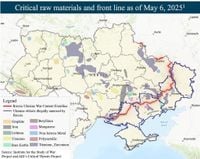As the ongoing conflict in Ukraine approaches the significant May 9 Victory Day celebrations, both Russian and Ukrainian forces are engaging in a series of military maneuvers that reflect the complex dynamics of the war. Recent reports indicate that Russian troops have made incremental territorial gains while Ukrainian forces have also managed to secure a foothold in Russian territory.
According to the latest updates, on May 6, 2025, Russian forces near Sumy and south of Pokrovsk gained 33 square miles, a marked increase from the 14 square miles captured the previous week. This brings the total area controlled by Russia since the full-scale invasion began on February 24, 2022, to approximately 27,410 square miles, representing about 12% of Ukraine's territory. When including Crimea and parts of the Donbas region, the total area under Russian control rises to 44,035 square miles, or 19% of Ukraine.
In contrast, Ukraine has also reported territorial gains, with its armed forces reclaiming 2 square miles this week, bringing their total to 5 square miles of Russian territory held, extending their control into the Belgorod region. This ongoing occupation complicates Russian President Vladimir Putin's narrative that all of Russia is liberated by the anniversary of World War II victory.
Military casualties continue to mount on both sides. An April 2025 estimate by U.S. Army General Mark Milley indicates that over 790,000 Russian soldiers have been killed or injured, with 48,000 reported missing. Ukrainian casualties are also significant, with President Volodymyr Zelenskyy estimating around 400,000 Ukrainian soldiers killed or injured and 35,000 missing.
The humanitarian impact of the war is profound, with approximately 10.2 million Ukrainians displaced, accounting for 23% of the pre-invasion population of 44 million. The economic repercussions are equally severe; Ukraine's economy has contracted by 22.6% since 2022, while Russia has seen a GDP growth of 5.6% during the same period, although forecasts for 2025 predict only 1.5% growth for Russia and a modest 2% recovery for Ukraine.
On the battlefield, the situation remains fluid. Ukrainian forces have engaged in drone strikes against Russian defense industrial facilities and airbases, targeting key installations such as the Fiber Optic Systems plant in Saransk, which is critical for the operation of drones on the battlefield. Ukrainian Center for Countering Disinformation Head Lieutenant Andriy Kovalenko reported that these strikes have caused significant damage, including a second fire at the Saranskkabel machine-building enterprise.
In a recent statement, U.S. Special Envoy to Ukraine General Keith Kellogg emphasized that Russia's refusal to agree to a proposed 30-day ceasefire is a major obstacle to peace. He noted that Russia is not winning the war and that its continued military actions are counterproductive. U.S. Vice President JD Vance echoed this sentiment, suggesting that Russia's demands for concessions are excessive.
Despite ongoing military operations, there are indications that both sides are open to negotiations. Kellogg stated that Ukraine is willing to sign a comprehensive ceasefire agreement, which would require both sides to withdraw 15 kilometers from the current frontline to establish a demilitarized zone. However, Russian officials, including Kremlin spokesperson Dmitry Peskov, have denied receiving any proposals from Ukraine regarding a demilitarized zone.
As preparations for Victory Day intensify, Russian authorities are reportedly planning to test their ability to disconnect large areas of the country from the internet. This move is seen as a way to control information during the celebrations and to mitigate any negative reports regarding Ukrainian strikes. Dmitry Peskov warned that mobile internet usage may be restricted on May 9 to ensure security during the festivities.
Additionally, Russian President Vladimir Putin and Venezuelan President Nicolás Maduro signed a strategic partnership agreement on May 7, 2025, aimed at enhancing defense cooperation and countering U.S. influence in the region. This agreement signifies Russia's ongoing efforts to strengthen ties with allies while facing international scrutiny over its military actions in Ukraine.
Reports of war crimes continue to emerge, with Ukrainian and European officials documenting Russian executions of Ukrainian prisoners of war (POWs) and the use of chemical weapons. The European Council is preparing a new sanctions package targeting Russian military units implicated in these violations.
As the battle for territorial control and public perception intensifies, the situation in Ukraine remains precarious. Both sides are preparing for potential escalations as they navigate the complex landscape of military engagement, international diplomacy, and humanitarian crises. The outcomes of these developments will likely shape not only the immediate future of the conflict but also the broader geopolitical landscape.

